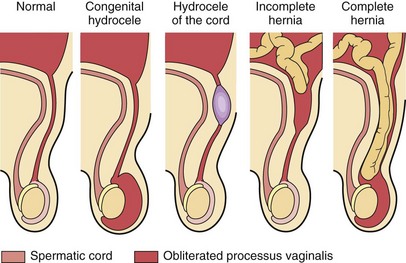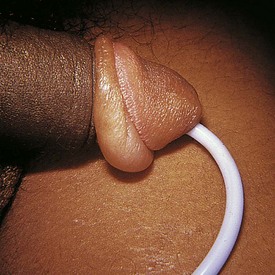20 Pediatric Genitourinary and Renal Disorders
• Children often cannot differentiate between abdominal pain and groin pain—a complete physical examination is therefore necessary.
• The pathophysiology, clinical findings, and treatment of paraphimosis, testicular torsion, and priapism are similar in both the pediatric and adult population. They are emergencies that require immediate intervention.
• The most common cause of acute renal failure in children is hemolytic-uremic syndrome.
• Poststreptococcal glomerulonephritis is the most common cause of acute glomerulonephritis. IgA nephropathy is the most commonly diagnosed cause of glomerulonephritis in adolescents.
• One third of patients with Henoch-Schönlein purpura have renal involvement. This disorder is the most common form of vasculitis in childhood and is usually characterized by the triad of abdominal pain, arthritis, and purpura.
Genitourinary Disorders
Hydrocele
A hydrocele (Fig. 20.1) is a collection of fluid that accumulates within the layers of the tunica vaginalis and may or may not communicate with the peritoneal space. Hydroceles are often present at birth and occur most frequently on the right side because of delayed migration of the right testicle. Noncommunicating hydroceles in older children and adolescents should prompt examination for epididymitis, orchitis, trauma, tumor, or testicular torsion.

Fig. 20.1 Abnormalities of the processus vaginalis.
(From Zitelli BJ, Davis HW. Atlas of pediatric physical diagnosis. 5th ed. Philadelphia: Mosby; 2007. Fig. 17-133.)
Varicocele
A varicocele is a collection of spermatic venous varicosities in the scrotum caused by incomplete drainage of the pampiniform plexus (Fig. 20.2). They are rare in children younger than 10 years. Varicoceles most commonly develop between 10 and 15 years of age and have an incidence of approximately 15% in males.1,2 The majority (85% to 95%) of varicoceles are left sided, the result of spermatic venous incompetence secondary to drainage of the left spermatic vein into the renal vein at a right angle.

Fig. 20.2 Varicocele.
(From Zitelli BJ, Davis HW. Atlas of pediatric physical diagnosis. 5th ed. Philadelphia: Mosby; 2007. Fig. 14-44.)
Clinical Presentation and Diagnosis
Right-sided varicoceles should prompt an evaluation for intraabdominal pathology such as thrombosis or a tumor causing compression of the inferior vena cava.3 Similarly, sudden onset of a left-sided varicocele should raise suspicion for renal cell carcinoma with obstruction of the left renal vein. The differential diagnosis of varicoceles and other scrotal masses is outlined in Table 20.1.
Testicular Torsion
The pathophysiology, clinical findings, and treatment of testicular torsion in the pediatric population is similar to that in adults. Detailed discussion of torsion can be found in Chapter 111.
Inguinal Hernia
An inguinal hernia occurs when an intraabdominal organ, usually intestine, herniates into a patent processus vaginalis (see Fig. 20.1). An incarcerated hernia refers to an intestinal loop that is not reducible. A strangulated hernia results when the blood supply to the intestinal loop is obstructed and bowel ischemia ensues.
Phimosis
Phimosis is a constriction of the penile foreskin that results in an inability to retract the prepuce over the glans. A fully retractable foreskin is present in 4% of newborns, 50% of 1-year-olds, 80% of 2-year-olds, and 90% of 4-year-olds. In the remaining cases, the foreskin may not be retractable until puberty.4
Paraphimosis
Paraphimosis is a urologic emergency in which the foreskin of an uncircumcised male is retracted behind the glans penis and acts as a constricting band (Fig. 20.3). The resulting venous and lymphatic congestion precludes returning the foreskin to its normal position, threatens arterial blood flow to the glans penis, and can result in penile necrosis, gangrene, or infarction of the glans over a period of hours to days. In infants and young boys, paraphimosis most commonly results after cleaning by a caretaker.

Fig. 20.3 Paraphimosis in a catheterized patient with an edematous prepuce proximal to the glans.
(From Zitelli BJ, Davis HW. Atlas of pediatric physical diagnosis. 5th ed. Philadelphia: Mosby; 2007.)
Stay updated, free articles. Join our Telegram channel

Full access? Get Clinical Tree








